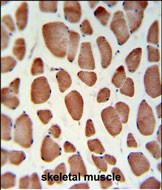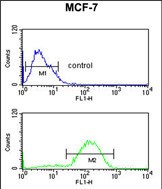HSD11B2 Antibody (Center)
Affinity Purified Rabbit Polyclonal Antibody (Pab)
- SPECIFICATION
- CITATIONS
- PROTOCOLS
- BACKGROUND

Application
| FC, IHC-P, WB, E |
|---|---|
| Primary Accession | P80365 |
| Reactivity | Human |
| Host | Rabbit |
| Clonality | Polyclonal |
| Isotype | Rabbit IgG |
| Calculated MW | 44127 Da |
| Antigen Region | 277-306 aa |
| Gene ID | 3291 |
|---|---|
| Other Names | Corticosteroid 11-beta-dehydrogenase isozyme 2, 111-, 11-beta-hydroxysteroid dehydrogenase type 2, 11-DH2, 11-beta-HSD2, 11-beta-hydroxysteroid dehydrogenase type II, -HSD11 type II, NAD-dependent 11-beta-hydroxysteroid dehydrogenase, 11-beta-HSD, HSD11B2, HSD11K |
| Target/Specificity | This HSD11B2 antibody is generated from rabbits immunized with a KLH conjugated synthetic peptide between 277-306 amino acids from the Central region of human HSD11B2. |
| Dilution | FC~~1:10~50 IHC-P~~1:50~100 WB~~1:1000 E~~Use at an assay dependent concentration. |
| Format | Purified polyclonal antibody supplied in PBS with 0.09% (W/V) sodium azide. This antibody is purified through a protein A column, followed by peptide affinity purification. |
| Storage | Maintain refrigerated at 2-8°C for up to 2 weeks. For long term storage store at -20°C in small aliquots to prevent freeze-thaw cycles. |
| Precautions | HSD11B2 Antibody (Center) is for research use only and not for use in diagnostic or therapeutic procedures. |
| Name | HSD11B2 (HGNC:5209) |
|---|---|
| Function | Catalyzes the conversion of biologically active 11beta- hydroxyglucocorticoids (11beta-hydroxysteroid) such as cortisol, to inactive 11-ketoglucocorticoids (11-oxosteroid) such as cortisone, in the presence of NAD(+) (PubMed:10497248, PubMed:12788846, PubMed:17314322, PubMed:22796344, PubMed:27927697, PubMed:30902677, PubMed:33387577, PubMed:7859916, PubMed:8538347). Functions as a dehydrogenase (oxidase), thereby decreasing the concentration of active glucocorticoids, thus protecting the nonselective mineralocorticoid receptor from occupation by glucocorticoids (PubMed:10497248, PubMed:12788846, PubMed:17314322, PubMed:33387577, PubMed:7859916). Plays an important role in maintaining glucocorticoids balance during preimplantation and protects the fetus from excessive maternal corticosterone exposure (By similarity). Catalyzes the oxidation of 11beta-hydroxytestosterone (11beta,17beta-dihydroxyandrost-4-ene-3-one) to 11-ketotestosterone (17beta-hydroxyandrost-4-ene-3,11-dione), a major bioactive androgen (PubMed:22796344, PubMed:27927697). Catalyzes the conversion of 11beta-hydroxyandrostenedione (11beta-hydroxyandrost- 4-ene-3,17-dione) to 11-ketoandrostenedione (androst-4-ene-3,11,17- trione), which can be further metabolized to 11-ketotestosterone (PubMed:27927697). Converts 7-beta-25-dihydroxycholesterol to 7-oxo-25- hydroxycholesterol in vitro (PubMed:30902677). 7-beta-25- dihydroxycholesterol (not 7-oxo-25-hydroxycholesterol) acts as a ligand for the G-protein-coupled receptor (GPCR) Epstein-Barr virus-induced gene 2 (EBI2) and may thereby regulate immune cell migration (PubMed:30902677). May protect ovulating oocytes and fertilizing spermatozoa from the adverse effects of cortisol (By similarity). |
| Cellular Location | Microsome. Endoplasmic reticulum |
| Tissue Location | Expressed in kidney, placenta, pancreas, prostate, ovary, small intestine and colon, and in lower levels in the spleen and testis (PubMed:7859916). At midgestation, expressed at high levels in placenta and in fetal kidney and, at much lower levels, in fetal lung and testis (PubMed:8530071). |

Thousands of laboratories across the world have published research that depended on the performance of antibodies from Abcepta to advance their research. Check out links to articles that cite our products in major peer-reviewed journals, organized by research category.
info@abcepta.com, and receive a free "I Love Antibodies" mug.
Provided below are standard protocols that you may find useful for product applications.
Background
There are at least two isozymes of the corticosteroid 11-beta-dehydrogenase, a microsomal enzyme complex responsible for the interconversion of cortisol and cortisone. The type I isozyme has both 11-beta-dehydrogenase (cortisol to cortisone) and 11-oxoreductase (cortisone to cortisol) activities. The type II isozyme, encoded by this gene, has only 11-beta-dehydrogenase activity. In aldosterone-selective epithelial tissues such as the kidney, the type II isozyme catalyzes the glucocorticoid cortisol to the inactive metabolite cortisone, thus preventing illicit activation of the mineralocorticoid receptor. In tissues that do not express the mineralocorticoid receptor, such as the placenta and testis, it protects cells from the growth-inhibiting and/or pro-apoptotic effects of cortisol, particularly during embryonic development. Mutations in this gene cause the syndrome of apparent mineralocorticoid excess and hypertension.
References
Li, J., et al. Breast Cancer Res. 12 (2), R19 (2010)
Ni, X.T., et al. Placenta 30(12):1023-1028(2009)
Mericq, V., et al. Eur. J. Endocrinol. 161(3):419-425(2009)
Stark, M.J., et al. Am. J. Physiol. Regul. Integr. Comp. Physiol. 297 (2), R510-R514 (2009)
Lepenies, J., et al. Clin. Exp. Hypertens. 31(4):376-379(2009)
If you have used an Abcepta product and would like to share how it has performed, please click on the "Submit Review" button and provide the requested information. Our staff will examine and post your review and contact you if needed.
If you have any additional inquiries please email technical services at tech@abcepta.com.













 Foundational characteristics of cancer include proliferation, angiogenesis, migration, evasion of apoptosis, and cellular immortality. Find key markers for these cellular processes and antibodies to detect them.
Foundational characteristics of cancer include proliferation, angiogenesis, migration, evasion of apoptosis, and cellular immortality. Find key markers for these cellular processes and antibodies to detect them. The SUMOplot™ Analysis Program predicts and scores sumoylation sites in your protein. SUMOylation is a post-translational modification involved in various cellular processes, such as nuclear-cytosolic transport, transcriptional regulation, apoptosis, protein stability, response to stress, and progression through the cell cycle.
The SUMOplot™ Analysis Program predicts and scores sumoylation sites in your protein. SUMOylation is a post-translational modification involved in various cellular processes, such as nuclear-cytosolic transport, transcriptional regulation, apoptosis, protein stability, response to stress, and progression through the cell cycle. The Autophagy Receptor Motif Plotter predicts and scores autophagy receptor binding sites in your protein. Identifying proteins connected to this pathway is critical to understanding the role of autophagy in physiological as well as pathological processes such as development, differentiation, neurodegenerative diseases, stress, infection, and cancer.
The Autophagy Receptor Motif Plotter predicts and scores autophagy receptor binding sites in your protein. Identifying proteins connected to this pathway is critical to understanding the role of autophagy in physiological as well as pathological processes such as development, differentiation, neurodegenerative diseases, stress, infection, and cancer.




